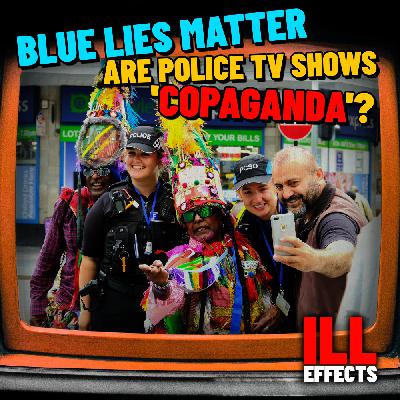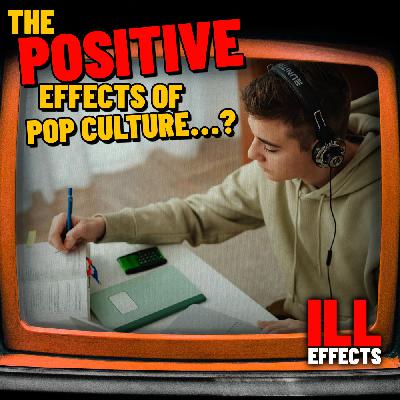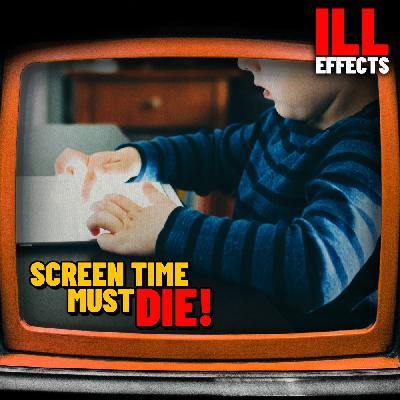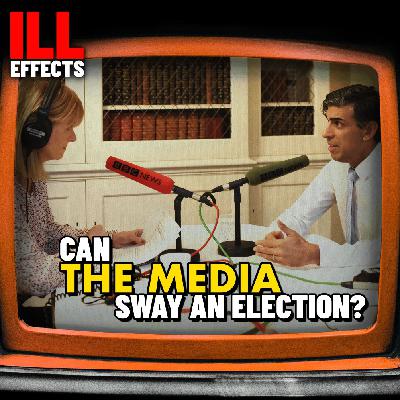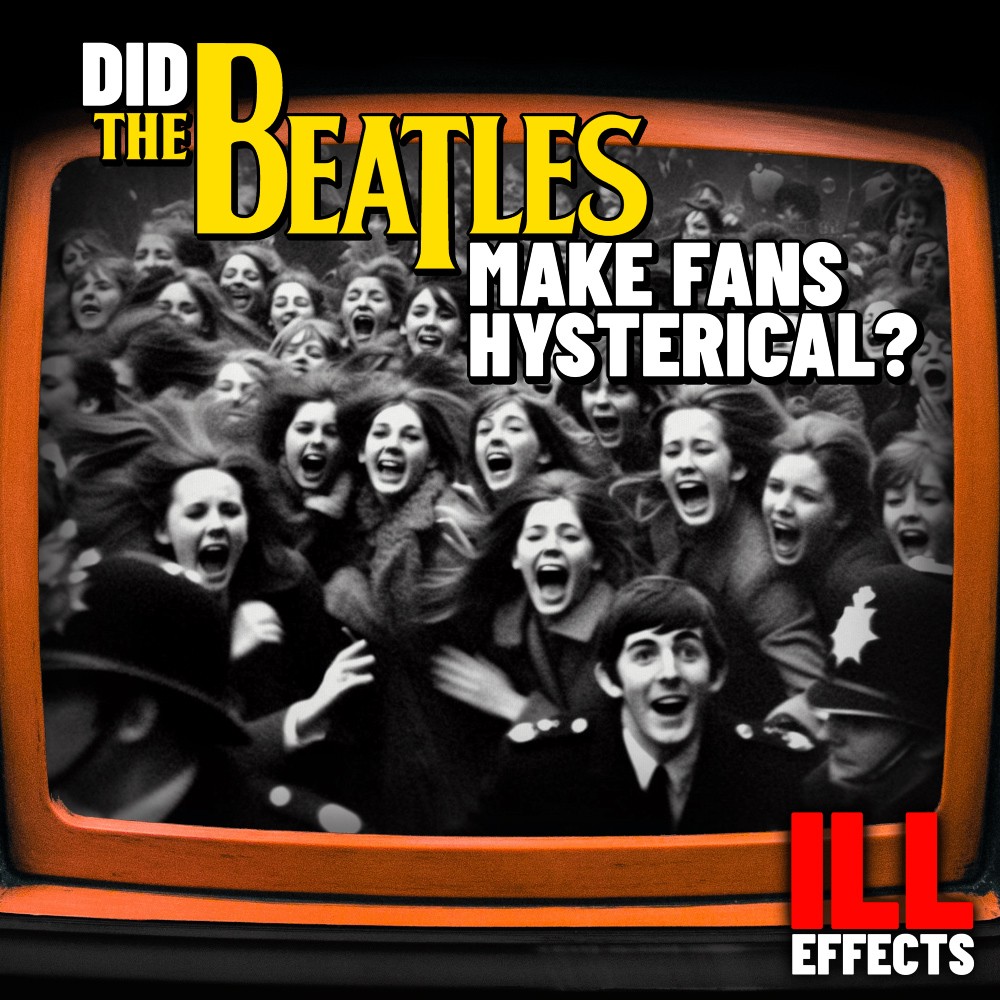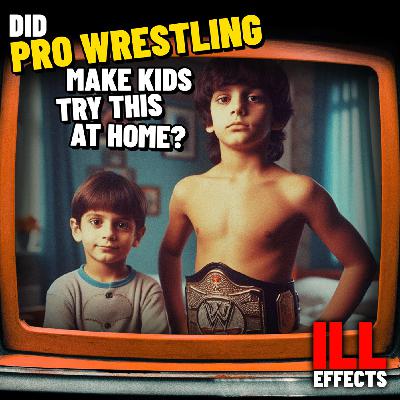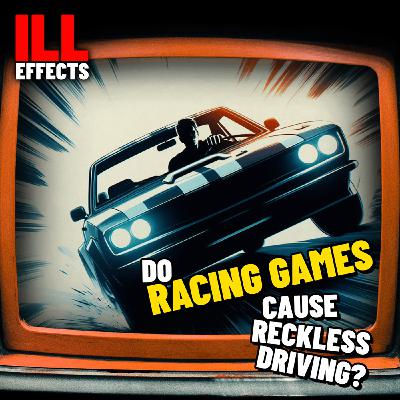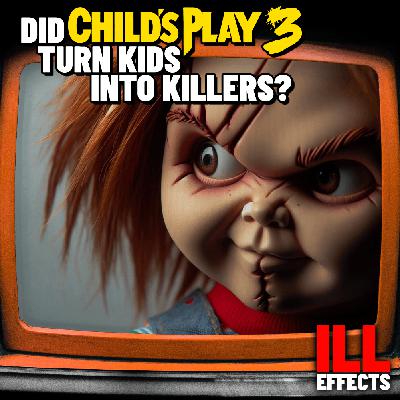Discover ILL EFFECTS
ILL EFFECTS

ILL EFFECTS
Author: Ben Litherland and Richard McCulloch
Subscribed: 11Played: 178Subscribe
Share
© Copyright 2024 All rights reserved.
Description
Can a horror film turn kids into killers? Can music make you more productive? Can a video game cause dangerous driving? Dr Rich McCulloch and Dr Ben Litherland investigate the bad faith arguments, dodgy data, and moral panics behind claims that the media influence our behaviour and manipulate our minds. Each episode they take a deep dive into the past and present of the media that have been said to cause any number of effects, researching music, video games, movies, books, toys, and more. What power does the media really have? Find out in the first series of bi-weekly discussions of Ill Effects.
21 Episodes
Reverse
In spring 2025, Andrew Tate was linked to a shocking murder case in the UK. Just days later, Netflix released Adolescence, a drama about a young killer seemingly shaped by the online manosphere. In this episode, we explore the history of the men’s rights movement, the politics of the manosphere, and the difficulty of drawing clear lines of influence around figures like Tate, however toxic their public presence may be.
Show Notes:
Adams, L (2025). 'Murders show online misogyny can cause real harm' BBC https://www.bbc.co.uk/news/articles/c5yr2yg58zjo
Botto, M., & Gottzén, L. (2024). Swallowing and spitting out the red pill: Young men, vulnerability, and radicalization pathways in the manosphere. Journal of Gender Studies, 33(5), 596–608.
Ging, D. (2019). Alphas, betas, and incels: Theorizing the masculinities of the manosphere. Men and Masculinities, 22(4), 638–657.
Haslop, C., Ringrose, J., Cambazoglu, I., & Milne, B. (2024). Mainstreaming the manosphere’s misogyny through affective homosocial currencies: Exploring how teen boys navigate the Andrew Tate effect. Social Media + Society, 10(1), 20563051241228811.
Ironwood, I. (2013). The manosphere: A new hope for masculinity. Londres: Red Pill.
Kennedy-Kollar, D. (2024). Extremism and radicalization in the manosphere: Beta uprising. Routledge.
Kimmel, M. S. (2018). The contemporary “crisis” of masculinity in historical perspective. In The making of masculinities Routledge.
King, J (2025). Tate and discovering Owen Cooper GQ https://www.gq-magazine.co.uk/article/stephen-graham-adolescence-interview-2025
Messner, M. A. (2016). Forks in the road of men's gender politics: Men's rights vs feminist allies. International Journal for Crime, Justice and Social Democracy, 5(2), 6–20.
Mudde, C The real story isn’t young men supposedly voting far right. It’s what young women are up to The Guardian https://www.theguardian.com/commentisfree/2025/may/21/young-men-women-far-right-online-politics-centre-left
Payne, J (2025). No coincidence killer ‘turned to Andrew Tate’ night before murders, court told The Independent https://www.independent.co.uk/news/uk/crime/andrew-tate-kyle-cambridge-crown-court-bbc-hmp-belmarsh-b2712870.html
Renström, E. A., & Bäck, H. (2024). Manfluencers and young men’s misogynistic attitudes: The role of perceived threats to men’s status. Sex Roles, 90(12), 1787–1806.
Rich, B Bujalka, E (2023). The draw of the manosphere: Understanding Andrew Tate’s appeal to lost men. The Conversation https://theconversation.com/the-draw-of-the-manosphere-understanding-andrew-tates-appeal-to-lost-men-199179
Roberts, S., Jones, C., Nicholas, L., Wescott, S., & Maloney, M. (2025). Beyond the clickbait: Analysing the masculinist ideology in Andrew Tate’s online written discourses. Cultural Sociology.
Shorrocks, Rosalind (2018). Young women are more left-wing than men, study reveals. The Conversation https://theconversation.com/young-women-are-more-left-wing-than-men-study-reveals-95624
Siegel, A. J. (n.d.). Facing my own misogyny: A content analysis of personal essays on the subreddit r/ExRedPill. RhetTech, 6(1), 2. https://rhettech.org/issues/facing-my-own-misogyny
Thomas-Parr, G., & Gilroy-Ware, M. (2025). ImPerceptible boyhood in a post-Andrew Tate world. Australian Feminist Studies, 1–22. https://doi.org/10.1080/08164649.2025.2320495
Thorburn, J. (2023). Exiting the manosphere: A gendered analysis of radicalization, diversion and deradicalization narratives from r/IncelExit and r/ExRedPill. Studies in Conflict & Terrorism, 1–25. https://doi.org/10.1080/1057610X.2023.2226593
YouTube. (n.d.). Andrew Tate Hustler's University full course part 1 [Video]. https://www.youtube.com/watch?v=XCoeJBdK36Q&t=140sBottom of Form
[Image via https://www.heute.at/i/ich-versklave-die-schlamn-die-tate-anklageschrift-100288002/doc-1h8hfqdbg0]
Note: Journal articles are often behind paywalls. If you don't have institutional access but would like a copy of these papers please email Illeffectspod@gmail.com and we will happily send you a copy
Credits:
Hosts – Rich McCulloch and Ben Litherland
Music by - Brutalust (Colin Frank and Maria Sappho), recorded and mixed by Joe Christman
Producer – Caroline Pringle
What if your favourite cop show was really a recruitment ad in disguise? This week, Rich introduces Ben to the world of on-screen ‘copaganda’. From Brooklyn Nine-Nine and The Wire through to TikTok lip-syncs and even Paw Patrol, is it a problem that TV cops are always so brave, so funny, and so good at breaking the rules for the ‘right’ reasons? What do these stories quietly teach us about crime, justice and law enforcement? Is the badge a prop... or a PR strategy?
Show Notes:
Bayley, David H. (1994) Police for the Future. Oxford University Press.
[Video] Brooklyn Nine-Nine (2018) “Jake Makes the Criminals Sing I Want It That Way | Brooklyn Nine Nine”, YouTube, 12th April.
Color of Change and USC Annenberg Normal Lear Center (2020) “Normalizing Injustice: The Dangerous Misrepresentations That Define Television’s Scripted Crime Genre”, January.
Davis, Elizabeth, and Anthony Whyde (2018) “Contacts Between Police and the Public, 2015”, U.S. Department of Justice, Bureau of Justice Statistics. October.
Herman, Edward S., and Noam Chomsky (1988) Manufacturing Consent: The Political Economy of Mass Media. Penguin.
Karakatsanis, Alec (2019) The Punishment Bureaucracy: How to Think About 'Criminal Justice Reform’. Yale Law Journal, 128, 28th March.
Karakatsanis, Alec (2025) Copaganda: How Police and the Media Manipulate Our News. The New Press.
Karakatsanis, Alec (2025) “How to Sniff Out ‘Copaganda’: When the Police and the Media Manipulate Our News”, Teen Vogue, 8th May.
Kennedy, Liam (2020) “Whenever there’s trouble, just yelp for help”: Crime, conservation, and corporatization in Paw Patrol. Crime Media Culture, 17(2).
Makam, Palika (2020) “Copaganda: What It Is and How to Recognize It”, Teen Vogue, 5th August.
The Onion (2017) ‘Paw Patrol’ Writers Defend Episode Where German Shepherd Cop Shoots Unarmed Black Lab 17 Times In Back. 16th July.
[Video] Particelli, Henry (2020) “Henry Particelli - "Your Name” (Official Music Video) Surprise Ending!!!!!” YouTube, 25th June.
Reiner, Robert (2008) “Policing and the Media” in Tim Newburn (ed.) Handbook of Policing, 2nd ed. Routledge, pp.313-335.
[Cold open music] Renda, David, “Sleek Panther”. Fesliyan Studios. https://www.fesliyanstudios.com/royalty-free-music/download/sleek-panther/2195
Salmon, Caspar (2021) “Puppet pups: is PAW Patrol authoritarian propaganda in disguise?” Guardian, 11th August.
[Video, part of an excellent series on Copaganda] Skip Intro (2020) “The Wire, Police Reform, and Capitalism | Copaganda Episode 4”, YouTube, 12th November.
[Video] Smack Mango (2021) “Cool Cops on TikTok”, YouTube, 5th April.
Vitale, Alex S. (2017) The End of Policing. Verso.
Tape wind Sound effect: Sound Effect by freesound_community from Pixabay
Note: Journal articles are often behind paywalls. If you don't have institutional access but would like a copy of these papers please email Illeffectspod@gmail.com and we will happily send you a copy
Credits:
Hosts – Rich McCulloch and Ben Litherland
Music by - Brutalust (Colin Frank and Maria Sappho), recorded and mixed by Joe Christman
producer – Caroline Pringle
In the summer of 2024, pop star Chappell Roan publicly called out her fans for being “creepy” and “weird,” asking, “if you saw a random woman on the street, would you yell at her from the car window?” Media coverage quickly seized on a familiar term to make sense of the incident: parasocial. But what does it really mean to have a parasocial relationship with a celebrity, and is it even the right term for what’s going on here? In this episode, Ben walks Rich through the surprising history of a now-mainstream academic concept. So, loyal listeners, don’t pretend like you know us (sorry, Mum).
Show Notes:
[Video] I Am Not Your Friend
‘I wouldn’t dream of telling a stranger I hated their laugh’: how does it feel when your social media followers cross a line? | Social media | The Guardian
Bucy, A. (2024). Normalising Fan Parasociality within Pathologising Traces Fan discourses of ‘good’and ‘bad’parasocial behaviours. Persona Studies, 10(2), 40-54.
Chen, C. P. (2016). Forming digital self and parasocial relationships on YouTube. Journal of Consumer culture, 16(1), 232-254.
Gamson, J. (2023). Claims to fame: Celebrity in contemporary America. Univ of California Press.
Hills, M. (2015). From para‐social to multisocial interaction: theorizing material/digital fandom and celebrity. A companion to celebrity, 463-482.
Horton, D., & Richard Wohl, R. (1956). Mass communication and para-social interaction: Observations on intimacy at a distance. Psychiatry, 19(3), 215-229.
Liebers, N., & Schramm, H. (2019). Parasocial interactions and relationships with media characters–an inventory of 60 years of research. Communication Research Trends, 38(2), 4-31.
Reijnders, S., Spijkers, M., Roeland, J., & Boross, B. (2014). Close encounters: Ritualizing proximity in the age of celebrity. An ethnographic analysis of meet-and-greets with Dutch singer Marco Borsato. European Journal of Cultural Studies, 17(2), 149-169.
Rojek, C. (2015). Presumed intimacy: Parasocial interaction in media, society and celebrity culture. John Wiley & Sons.
Too close for comfort: the pitfalls of parasocial relationships | Social media | The Guardian
Tukachinsky, R., Walter, N., & Saucier, C. J. (2020). Antecedents and effects of parasocial relationships A meta-analysis. Journal of Communication, 70(6), 868-894
University study looks at YouTube and parasocial relationships - BBC News
Why are TikTok creators so good at making people buy things? - BBC Worklife
Why we feel so close: The science behind parasocial relationships with musicians
You are not that singer’s best friend!: The dangers of parasocial relationships in the music industry - The Boar
Note: Journal articles are often behind paywalls. If you don't have institutional access but would like a copy of these papers please email Illeffectspod@gmail.com and we will happily send you a copy
Credits:
Hosts – Rich McCulloch and Ben Litherland
Music by - Brutalust (Colin Frank and Maria Sappho), recorded and mixed by Joe Christman
producer – Caroline Pringle
This week, Rich fires up the dial-up and drags Ben back to the '90s, when computer porn was “technology’s HIV” and the moral panic went full throttle. It’s ILL EFFECTS bingo: lurid headlines, laughable research, ominous documentary music, and a truly cursed TIME magazine cover of a man trying to get jiggy with his computer monitor.
Credits:
Hosts – Rich McCulloch and Ben Litherland
Music by - Brutalust (Colin Frank and Maria Sappho), recorded and mixed by Joe Christman
Producer – Caroline Pringle
Can television make you kinder? Can video games make you smarter? Can porn improve your maths skills? Wait, what? In this episode, Ben walks Rich through a curious set of popular claims circulating in online blogs: that pop culture might be having positive effects. But what’s the evidence behind these claims? And what does their popularity reveal about how we understand news, science, and ultimately our own anxieties about work and leisure?
Show Notes:
Litherland, B. (2025). Smarter, better, faster, kinder? The problems with claiming that media and popular culture has positive effects. International Journal of Cultural Studies, 13678779251337761.
Note: Journal articles are often behind paywalls. If you don't have institutional access but would like a copy of these papers please email Illeffectspod@gmail.com and we will happily send you a copy
Credits:
Hosts – Rich McCulloch and Ben Litherland
Music by - Brutalust (Colin Frank and Maria Sappho), recorded and mixed by Joe Christman
Producer – Caroline Pringle
Ill effects does Hot Ones! Ben and Rich talk about using hot sauce as a measure of aggression in lab-based experiments when studying the relationship between media and violence. They do this while unwisely eating increasingly hot hot sauces. Where did this research come from, why are their mouths burning? All this and more. “Hey, look at us. Who would have thought? Not me!”
Show Notes:
Krahé, B. (2014). Restoring the spirit of fair play in the debate about violent video games. European Psychologist.
Lieberman, J. D., Solomon, S., Greenberg, J., & McGregor, H. A. (1999). A hot new way to measure aggression: Hot sauce allocation. Aggressive Behavior: Official Journal of the International Society for Research on Aggression, 25(5), 331-348.
Markey, P. M., Markey, C. N., & French, J. E. (2015). Violent video games and real-world violence: Rhetoric versus data. Psychology of Popular Media Culture, 4(4), 277.
McCarthy, R. J., & Elson, M. (2018). A conceptual review of lab-based aggression paradigms. Collabra: Psychology, 4(1).
Plante, C., Anderson, C. A., Allen, J. J., Groves, C. L., & Gentile, D. A. (2020). Game On!: Sensible Answers about Video Games and Media Violence. Zengen LLC.
Ritter, D., & Eslea, M. (2005). Hot sauce, toy guns, and graffiti: A critical account of current laboratory aggression paradigms. Aggressive Behavior: Official Journal of the International Society for Research on Aggression, 31(5), 407-419.
Tedeschi, J. T., & Quigley, B. M. (1996). Limitations of laboratory paradigms for studying aggression. Aggression and Violent Behavior, 1(2), 163-177.
Note: Journal articles are often behind paywalls. If you don't have institutional access but would like a copy of these papers please email Illeffectspod@gmail.com and we will happily send you a copy
Credits:
Hosts – Rich McCulloch and Ben Litherland
Title Music by - Brutalust (Colin Frank and Maria Sappho), recorded and mixed by Joe Christman
Producer – Caroline Pringle
Dramatic Music by Dmitry Taras from Pixabay – dramatic
Knife crime, hip hop, and... Vanessa Carlton?!? In 2018, drill music became known as the soundtrack to social collapse—accused of inciting violence, corrupting youth, and starting gang wars via YouTube beef. But Rich shows Ben that behind the panic lies a familiar story: bad data, racial scapegoating, and a government more comfortable censoring rap than tackling inequality. Hang on until the end for a bizarre cameo from a very confused young offenders’ playlist.
Credits:
Hosts – Rich McCulloch and Ben Litherland
Music by - Brutalust (Colin Frank and Maria Sappho), recorded and mixed by Joe Christman
Producer – Caroline Pringle
Cover image: “Skengdo & AM backstage at Greener on the Other Side EP Launch, Ace Hotel, Shoreditch” (2018) https://commons.wikimedia.org/wiki/File:Skengdo_x_AM.jpg
Air Horn: Sound Effect by Waitwhatimsignedin from Pixabay
Air Horn 2: Sound Effect by SonixFXSounds from Pixabay
[Eat popcorn!] In 1957, market researcher James Vicary promised he could flash split-second commands on movie screens and subconsciously influence audiences to buy things. He called it subliminal advertising. [Drink Coca-Cola!] Ben drags Rich through the riotous history of hidden persuasion, packed with hucksters, gimmicks, and shrinks. But as silly as these experiments were, what do they reveal about our relationships to advertising today? [Consume!]
Show Notes:
Acland, C. R. (2011). Swift viewing The popular life of subliminal influence. Duke University Press.
Crandall, K. B. (2006). Invisible commercials and hidden persuaders: James M. Vicary and the subliminal advertising controversy of 1957. Undergraduate Honors Thesis. University of Florida. Available at http://plaza. ufl. edu/cyllek/docs/KCrandall_Thesis2006. pdf.
Fullerton, Ronald A. "The Devil's Lure?: Motivation Research, 1934-1954." In Proceedings of the Conference on Historical Analysis and Research in Marketing, vol. 12, pp. 134-143. 2005.
Heffernan, K. (2002). The hypnosis horror films of the 1950s: Genre texts and industrial context. Journal of Film and Video, 54(2/3), 56-70.
Horowitz, D. (1994). Vance Packard & American Social Criticism. Univ of North Carolina Press.
Key, W. B. (1973). Subliminal seduction: Ad media’s manipulation of a not so innocent America. Englewood Cliffs, NJ: Prentice-Hall.
Mackay, J., & Anonymous. (2023). Hypnosis and pornography: a cultural history. Porn Studies, 10(1), 82-98.
Parkin, K. (2004). The sex of food and Ernest Dichter: the illusion of inevitability. Advertising & Society Review, 5(2).
Samuel, L. R. (2010). Freud on Madison Avenue: motivation research and subliminal advertising in America. University of Pennsylvania Press.
[Video] Aldous Huxley interviewed by Mike Wallace
[Video] Daniels, Harold (1958) My World Dies Screaming
Note: Journal articles are often behind paywalls. If you don't have institutional access but would like a copy of these papers please email Illeffectspod@gmail.com and we will happily send you a copy
Credits:
Hosts – Rich McCulloch and Ben Litherland
Music by - Brutalust (Colin Frank and Maria Sappho), recorded and mixed by Joe Christman
Producer – Caroline Pringle
Depression. Anxiety. Sleep deprivation. Addiction. The headlines about "screen time" and today’s kids sound like the end of the world. But in the Season 2 opener of ILL EFFECTS, Rich walks Ben through the panic—and the patchy science propping it up. He argues it’s time to ditch the outdated idea of screen time altogether, and to replace it with a smarter, more nuanced conversation about how, when, and why we use modern media.
NOTE: The initial version of this episode (published 10th April 2025) had some sound issues, a new version was published 17th April 2025.
Credits:
Hosts – Rich McCulloch and Ben Litherland
Music by - Brutalust (Colin Frank and Maria Sappho), recorded and mixed by Joe Christman
Producer – Caroline Pringle
Sound Effect by Devrinta Rose Nataya from Pixabay
Sound Effect by Rasool Asaad from Pixabay
Cover art photo by Kelly Sikkema on Unsplash
In this bumper Very Special Episode ahead of this week’s UK General Election, we take it in turns to examine whether “the media” can “sway” election results. First, Ben examines the always-silly and sometimes-sinister British tabloid press and their (in)famous claim that it was “The Sun Wot Won It” for John Major in 1992. Rich then looks at Cambridge Analytica, and the claims that its Facebook quizzes helped make Brexit happen. Politics podcasts deserve better: vote for ILL EFFECTS!
WE NEED YOU: Click HERE to complete our listener survey and help shape future episodes!
Show Notes:
SOURCES AND LINKS:
Afriat, H., et al. (2021) “This is capitalism. It is not illegal”: Users’ attitudes toward institutional privacy following the Cambridge Analytica scandal. The Information Society, 37(2).
BBC (2018) “Cambridge Analytica: The data firm's global influence,” BBC News, 22nd March.
BBC (2020) “Cambridge Analytica 'not involved' in Brexit referendum, says watchdog,” BBC News, 7th October.
Berghel, H. (2018) “Malice Domestic: The Cambridge Analytica Dystopia,” Computer, 51(5), May.
Bruns, A. (2019) Are Filter Bubbles Real? Polity Press.
Cadwalladr, C., and Graham-Harrison, E. (2018) “Revealed: 50 million Facebook profiles harvested for Cambridge Analytica in major data breach,” The Guardian, 17th March.
Curtice, J. "Was it The Sun wot won it again? The influence of newspapers in the 1997 election campaign." Centre for research into elections and social trends working papers 75 (1999).
De Vany, A. (2004) Hollywood Economics: How extreme uncertainty shapes the film industry. Routledge.
Druckman, J. N. (2005). Media matter: How newspapers and television news cover campaigns and influence voters. Political communication, 22(4), 463-481.
Fuchs, C. (2013) Social Media: A Critical Introduction. Sage.
Gunther, A. C., Perloff, R. M., & Tsfati, Y. (2008). Public opinion and the third-person effect. The SAGE handbook of public opinion research, 184-191.
Heawood, J. (2018) “Pseudo-public political speech: Democratic implications of the Cambridge Analytica scandal,” Information Polity, 23.
Hern, A. (2018) "Cambridge Analytica: how did it turn clicks into votes?” The Guardian, 6th May.
Linton, M. (1996). Maybe The Sun won it after all. British Journalism Review, 7(2), 20-26.
Parliament.UK (2018) “The issue of data targeting, based around the Facebook, GSR and Cambridge Analytica allegations.” Disinformation and ‘fake news’: Interim Report. 29th July.
Price, V., & Feldman, L. (2009). News and politics. The Sage Handbook of Media Processes and Effects. Los Angeles: Sage Publications, 113-129.
Rathi, R. (2019) “Effect of Cambridge Analytica’s Facebook ads on the 2016 US Presidential Election,” Towards Data Science, 13th January.
Reeves, A., McKee, M., & Stuckler, D. (2016). ‘It's The Sun Wot Won It’: Evidence of media influence on political attitudes and voting from a UK quasi-natural experiment. Social science research, 56, 44-57.
Risso, L. (2018) ‘Harvesting Your Soul? Cambridge Analytica and Brexit’ in Jansohn, C. (ed.) Brexit Means Brexit? The Selected Proceedings of the Symposium, Akademie der Wissenschaften und der Literatur -- Mainz 6–8 December 2017. Akademie der Wissenschaften und der Literatur, Mainz.
Strömbäck, J. (2011). Mediatization and perceptions of the media's political influence. Journalism studies, 12(4), 423-439.
Thomas, J. (2007). Popular newspapers, the Labour Party and British politics. Routledge.
Wong, J. C., et al. (2018) “How academic at centre of Facebook scandal tried – and failed – to spin personal data into gold,” The Guardian, 24th April.
Note: Journal articles are often behind paywalls. If you don't have institutional access but would like a copy of these papers please email Illeffectspod@gmail.com and we will happily send you a copy
Episode artwork photo by Simon Dawson / No 10 Downing Street. Used under Creative Commons license (ATTRIBUTION-NONCOMMERCIAL-NODERIVS 2.0 GENERIC).
Credits:
Hosts – Rich McCulloch and Ben Litherland
Music by - Brutalust (Colin Frank and Maria Sappho), recorded and mixed by Joe Christman
Creative producer – Rachel Wood
Technical producer – Caroline Pringle
Technical production – Colin Frank
In the 1960s, parents, the press, psychologists, and many others were confronted with a large, terrifying, global problem: Beatlemania. In this episode, Ben talks Rich through how the world tried to make sense of the screaming, potentially hysterical, pop fan. We encounter theories of red goddesses (what were shrinks taking in the 60s?), anti-communist creeds, and Adrienne from Brooklyn that really, really loves Paul.
Show Notes
Sources and Links
[Video] A taste of Beatlemania in the 1960s
[Video] CBS News reports on the Beatles in 1964
“What the Beatles Prove About Teen-agers” (1962) U.S. News & World. 24 February.
Berman, G. (2007). "We're Going to See the Beatles!": An Oral History of Beatlemania as Told by the Fans who Were There. Santa Monica Press.
Davies, E. (1969). Psychological characteristics of Beatle mania. Journal of the History of Ideas, 30(2), 273-280.
Dempsey, D. (1964). Why the Girls Scream, Weep, Flip. The path to understanding is psychological, anthropological and a whole lot besides. New York Times Magazine, 23.
Ehrenreich, B., Hess, E., & Jacobs, G. (1992). “Beatlemania: Girls just want to have fun” In Lisa A. Lewis (ed) The Adoring Audience Routledge.
Leonard, C. (2016). Beatleness: How the Beatles and their fans remade the world. Skyhorse.
Millard, A. (2012). Beatlemania: Technology, Business, and Teen Culture in Cold War America. JHU Press.
Mills, R. (2019). The Beatles and Fandom: Sex, Death and Progressive Nostalgia. Bloomsbury Publishing USA.
Taylor, A. J. W. (1966). “Beatlemania—A study in adolescent enthusiasm”. British Journal of Social and Clinical Psychology, 5(2), 81-88.
Taylor, A. J. W. (2014). “The 1964 Wellington Study of Beatlemania Revisited”, Psychology, 5(15), 1844.
Van Luling, T. (2017) “11 Things You Probably Didn't Know About The Beatles, Even If You're A Superfan”, Huffington Post. 7 December.
Womack, K., & O'Toole, K. (Eds.). (2021). Fandom and the Beatles: The Act You've Known for All These Years. Oxford University Press, USA.
Note: Journal articles are often behind paywalls. If you don't have institutional access but would like a copy of these papers please email Illeffectspod@gmail.com and we will happily send you a copy
Credits:
Hosts – Rich McCulloch and Ben Litherland
Music by - Brutalust (Colin Frank and Maria Sappho), recorded and mixed by Joe Christman
Creative producer – Rachel Wood
Technical producer – Caroline Pringle
Technical production – Colin Frank
Can media representations of suicide really be “contagious”, driving vulnerable audiences to end their own lives? Rich introduces Ben to a frustratingly large field of psychologists, counsellors and youth charities who made this argument about the Netflix series 13 Reasons Why. We dive head-first into both the controversy and the research behind it, to figure out why so many smart, well-intentioned people keep getting this issue so wrong.
CONTENT WARNING: this episode includes discussion of suicide and its causes, clips where people discuss their suicidal feelings. It also contains passing references to sexual assault.
If you or someone you know is having suicidal feelings, please seek help immediately. If you are in the UK, the following hotlines all provide support free of charge:
Samaritans: 116 123 (24 hours)
NHS: 111 (24 hours)
SANEline: 0300 304 7000 (4.30pm-10pm)
National Suicide Prevention Helpline UK: 0800 689 5652 (6pm-midnight)
Campaign Against Living Miserably (CALM): 0800 58 58 58 (5pm-midnight)
Papyrus (for those under 35 and struggling with suicidal feelings, or concerned about a young person who is struggling): 0800 068 4141 (24 hours)
Switchboard (support line for any matters relating to LGBTQIA+ identity): 0800 119 100 (10am-10pm)
If you would prefer not to talk over the phone, the following services are available:
Samaritans: email jo@samaritans.org
Shout (mental health support): Text SHOUT to 85258
Papyrus (for those under 35 and struggling with suicidal feelings, or concerned about a young person who is struggling): email pat@papyrus-uk.org or text 07786 209 697
Switchboard (LGBTQIA+ support service): Chat service via their website at switchboard.lgbt (after 5pm), or email chris@switchboard.lgbt
For listeners in countries outside of the UK, a useful list of hotlines and other support resources can be found here: https://en.wikipedia.org/wiki/List_of_suicide_crisis_lines#Crisis_lines_by_country
Credits:
Hosts – Rich McCulloch and Ben Litherland
Music by - Brutalust (Colin Frank and Maria Sappho), recorded and mixed by Joe Christman
Creative producer – Rachel Wood
Technical producer – Caroline Pringle
Technical production – Colin Frank
After a defence lawyer blamed the killing of a six-year-old on pro wrestling, the Parents Television Council went to war with the World Wrestling Federation. Lifelong pro wrestling fan, Ben, talks Rich through this bad blood feud: in one corner “family values” and in the other corner the sex and violence of “attitude era” pro wrestling. We explore the increasingly fraught tactics used by both organizations, and, surprisingly, what the battle tells us about modern culture wars, the American right, and Donald Trump. Let’s get ready to rumblllleeee.
Show Notes:
Bozell, B (2023) Free Speech Week calls for a return to First Amendment liberties. Washington Examiner. Oct. 20.
Calvert, C., & Richards, R. D. (2010). The Parents Television Council Uncensored: An Inside Look at the Watchdog of the Public Airwaves and the War on Indecency with Its President, Tim Winter. Hastings Comm. & Ent. LJ, 33, 293
Dale, M. J. (2003). Making Sense of the Lionel Tate Case. Nova L. Rev., 28, 467.
Farhi, P (2002) TV Watchdog Apologizes for False Claims on Wrestling. The Washington Post. 9th July.
Foley, M (2001) Foley Is Good: And the Real World Is Faker Than Wrestling. Regan Books.
Lowney, K. S. (2003). Wrestling with Criticism: The World Wrestling Federation's Ironic Campaign against the Parents Television Council. Symbolic Interaction, 26(3), 427-446.
Sagba, C (2000) Vince McMahon Talks About Suing PTC and Negotiations with WCW!, IGN, June 18th,
Sammond, N. (2005). Squaring the family circle: WWF Smackdown assaults the social body. In Sammond, N. (Ed.) Steel chair to the head: the pleasure and pain of professional wrestling. Duke University Press, pp.132-166.
Specer, T (2000) Is Pro Wrestling to Blame for girls death? South Coast Today. 16th April.
[Video] The Rock Confronts Right to Censor At Smackdown
Note: Journal articles are often behind paywalls. If you don't have institutional access but would like a copy of these papers please email Illeffectspod@gmail.com and we will happily send you a copy
Credits:
Hosts – Rich McCulloch and Ben Litherland
Music by - Brutalust (Colin Frank and Maria Sappho), recorded and mixed by Joe Christman
Creative producer – Rachel Wood
Technical producer – Caroline Pringle
Technical production – Colin Frank
In 2020, a French indie movie called Cuties somehow found itself at the epicentre of the US culture wars. Outraged conservatives accused the filmmakers and Netflix of encouraging paedophilia and stoking the fires of global child sex trafficking trade. But were they right? Rich’s deep dive into the controversy takes Ben on a journey through “sexualisation,” twerking, Tucker Carlson’s gormless face, School of Rock, QAnon, and yes... even paedophilic robots.
Show Notes:
Sources and links
Barker, Martin, Jane Arthurs, Jane and Ramaswami Harindranath (2001) The Crash Controversy: Censorship Campaigns and Film Reception. Wallflower Press.
Barker, Martin (2009) “The Challenge of Censorship: ‘Figuring’ Out the Audience,” Velvet Light Trap, 63.
Barker, Martin, with Thomas Austin (2000) From Antz to Titanic: Reinventing Film Analysis. Pluto Press.
Buchanan, Vern (2020) “Buchanan Slams Netflix Film ‘Cuties’ for Exploiting Young Girls,” September 13. [Press Release]
Carlson, Tucker (2020) “From ‘WAP’ to an 11-year-old twerking girl,” Tucker Carlson Tonight, August 21. [Twitter/X video clip, posted by @ColumbiaBugle]
Carlson, Tucker (2020) “Netflix Slammed for Sexualizing Young Girls,” Tucker Carlson Tonight, September 11. [Facebook video]
Cassam, Quassim (2019) Conspiracy Theories. Polity.
Cruz, Ted (2020) “SEN. CRUZ CALLS FOR CRIMINAL INVESTIGATION INTO NETFLIX’S ‘CUTIES’,” September 11. [Press Release]
Dickson, E.J. (2020) “How ‘Cuties’ Is Fueling the Far Right’s Obsession With Pedophilia,” Rolling Stone, September 14.
Dickson, E.J. (2020) “Netflix’s Cuties Was Just Charged With Lewdness. But That’s Not the Full Story,” Rolling Stone, October 8.
Egan, R. Danielle (2013) Becoming Sexual: A Critical Appraisal of the Sexualization of Girls. Polity Press.
Egan, R. Danielle and Gail L. Hawkes (2007) “Producing the Prurient through the Pedagogy of Purity: Childhood Sexuality and the Social Purity Movement,” Journal of Historical Sociology, 20(4).
Egan, R. Danielle and Gail L. Hawkes (2008) “Endangered Girls and Incendiary Objects: Unpacking the Discourse on Sexualization," Sexuality and Culture, 12.
Egan, R. Danielle and Gail L. Hawkes (2008) “Girls, Sexuality and the Strange Carnalities of Advertisements: Deconstructing the Discourse of Corporate Paedophilia,” Australian Feminist Studies, 23(57).
Egan, R. Danielle and Gail L. Hawkes (2009) “The problem with protection: Or, why we need to move towards recognition and the sexual agency of children,” Continuum, 23(3).
Egan, R. Danielle and Gail L. Hawkes (2013) “Disavowal and foundational fantasies: A psychosocial exploration of the class, race and the social construction of the sexual child in the Anglophone West,” Sexualities, 16(5/6).
Gallagher, Danny (2022) “District Attorney Lucas Babin? Where Have We Heard That Name? Oh, Right! School of Rock!” Dallas Observer, April 4.
Givas, Nick (2020) “Rep. Ken Buck calls for investigation into 'exploitation of children' in letter to DOJ regarding Netflix film 'Cuties',” Fox News, September 14.
Grater, Tom (2020) “‘Cuties’ Director Says She Received Death Threats After Netflix Poster Backlash; Ted Sarandos Called Her To Apologize,” Deadline, September 3. [Contains images of the contrasting French and American posters]
Gray, Jonathan (2010) Show Sold Separately: Promos, Spoilers, and Other Media Paratexts. New York University Press.
McCulloch, Richard, and William Proctor (2023) “The Cuties Controversy: Prefiguration, ‘Sexualisation’ and the New Conspiracism,” Participations, 19(3).
Netflix (2020) “Cuties | Official Trailer | Netflix,” [YouTube]
Paasonen, Susanna, et al. (2020) Objectification: On the Difference between Sex and Sexism. Routledge.
Rosen, Christopher (2020) “Netflix Apologizes for “Inappropriate” Cuties Poster That Sexualized Child Stars,” Vanity Fair, August 20.
Rosenblum, Nancy L., and Russell Muirhead (2019) A Lot of People Are Saying: The New Conspiracism and the Assault on Democracy. Princeton University Press.
Schiffer, Zoë (2021) “Netflix scrambled internally to suppress a controversial movie from search results,” The Verge, October 27.
Note: Journal articles are often behind paywalls. If you don't have institutional access but would like a copy of these papers please email Illeffectspod@gmail.com and we will happily send you a copy
Credits:
Hosts – Rich McCulloch and Ben Litherland
Music by - Brutalust (Colin Frank and Maria Sappho), recorded and mixed by Joe Christman
Creative producer – Rachel Wood
Technical producer – Caroline Pringle
Technical production – Colin Frank
From Death Race to Grand Theft Auto, driving games have long fuelled claims that players might be inspired to start mowing down pedestrians outside of the game. Starting with a story about a Toronto police officer linking a hit and run to a copy of Need for Speed found on the offender’s passenger seat, Ben talks Rich through the surprisingly longstanding history of links between video games and reckless driving. We encounter early arcade video games, clowns being run over at anti-car carnivals, and Adam West’s Batman doing British road safety videos. Crash! Bang! Wallop! What a podcast!
Show Notes:
[Video] 1967 Adam West Batman UK Public Service Announcement
Beullens, K., Roe, K., & Van den Bulck, J. (2008). Video games and adolescents' intentions to take risks in traffic. Journal of Adolescent Health, 43(1), 87-90.
Carsten, O., & Jamson, A. H. (2011). Driving simulators as research tools in traffic psychology. In Handbook of traffic psychology (pp. 87-96). Academic Press.
[Video] Death Race News Report
Fischer, P., Greitemeyer, T., Morton, T., Kastenmüller, A., Postmes, T., Frey, D., ... & Odenwälder, J. (2009). The racing-game effect why do video racing games increase risk-taking inclinations. Personality and Social Psychology Bulletin, 35(10), 1395-1409.
Howard, J., Bowden, V. K., & Visser, T. (2023). Do action video games make safer drivers? The effects of video game experience on simulated driving performance. Transportation research part F: traffic psychology and behaviour, 97, 170-180.
Hull, J. G., Draghici, A. M., & Sargent, J. D. (2012). A longitudinal study of risk-glorifying video games and reckless driving. Psychology of Popular Media Culture, 1(4), 244.
Kocurek, C. A. (2012). The agony and the Exidy: a history of video game violence and the legacy of Death Race. Game Studies, 12(1).
Lumsden, K. (2013). Boy racer culture: Youth, masculinity and deviance. Routledge.
(2006) “NFS found in fatal drag-racing car crash”, Game Spot, Jan 26th.
Norton, P. D. (2007). Street rivals: Jaywalking and the invention of the motor age street. Technology and culture, 48(2), 331-359.
Redshaw, S. (2017). In the company of cars: Driving as a social and cultural practice. CRC Press.
Sala, G., Tatlidil, K. S., & Gobet, F. (2018). Video game training does not enhance cognitive ability: A comprehensive meta-analytic investigation. Psychological bulletin, 144(2), 111..
Stinchcombe, A., Kadulina, Y., Lemieux, C., Aljied, R., & Gagnon, S. (2017). Driving is not a game: Video game experience is associated with risk-taking behaviours in the driving simulator. Computers in Human Behavior, 69, 415-420.
Vingilis, E., Seeley, J., Wiesenthal, D. L., Wickens, C. M., Fischer, P., & Mann, R. E. (2013). Street racing video games and risk-taking driving: An Internet survey of automobile enthusiasts. Accident Analysis & Prevention, 50, 1-7.
Note: Journal articles are often behind paywalls. If you don't have institutional access but would like a copy of these papers please email Illeffectspod@gmail.com and we will happily send you a copy
Credits:
Hosts – Ben Litherland & Rich McCulloch
Music by - Brutalust (Colin Frank and Maria Sappho), recorded and mixed by Joe Christman
Creative producer – Rachel Wood
Technical producer – Caroline Pringle
Technical production – Colin Frank
Before “deep focus” and “study beats” playlists came muzak—one of the most widespread (and widely hated) forms of music of the 20th Century. But does background music really have the power to improve worker productivity? To dictate our wine preferences? Or, God forbid, even affect how long we spend in our favourite brothel?!? Rich shows Ben that the genre’s history doesn’t always make for easy listening.
Show Notes:
Sources and links:
Advertising Cliche (n.d.) “The Visual Primer of Advertising Cliches: Muzak Corporation” [amazing online archive of historical print ads]
Allan, David (2008) “Sound retailing: A Review of Experimental Evidence on the Effects of Music on Shopping Behavior,” in Tina M. Lowrey, ed. Brick & Mortar Shopping in the 21st Century. Lawrence Erlbaum Associates.
Anderson, Paul Allen (2015) “Neo-muzak and the business of mood,” Critical Inquiry, 41(4).
Bradshaw, Alan, and Morris B. Holbrook (2008) “Must we have Muzak wherever we go? A critical consideration of the consumer culture,” Consumption, Markets and Culture, 11(1).
Camp, Gregory (2017) "Mickey Mouse Muzak: Shaping Experience Musically at Walt Disney World,” Journal of the Society for American Music, 11(1).
Chebat, Jean-Charles, Dominique Valiant, and Gelinas-Chebat (2000) “Does Background Music in a Store Enhance Salespersons' Persuasiveness?” Perceptual and Motor Skills, 91.
Hulyer, Jake (2018) “Inside the booming business of background music,” Guardian, 6th November.
Illouz, Eva (2018) “Introduction: emodities or the making of emotional commodities.” In Illouz, ed. Emotions as Commodities: Capitalism, Consumption and Authenticity. Routledge.
Inside the Score (2022) “Satie's Furniture Music: Designed to be Ignored?” [YouTube]
Gorbman, Claudia (1987) Unheard Melodies: Narrative Film Music. Indiana University Press.
Jones, Simon C. and Thomas G. Schumacher (1992) “Muzak: On Functional Music and Power,” Critical Studies in Mass Communication, 9(2).
Kotler, Philip (1974) “Atmospherics as a Marketing Tool,” Journal of Retailing, 49(4).
Lanza, Joseph (1994) Elevator Music: A Surreal History of Muzak, Easy-Listening, and Other Moodsong. 1st ed. Picador.
Mercer, Jason C. (2018) “Elevator Music -- MUZAK -- Stimulus Progression” [YouTube]
[Muzak ads archived]
North, Adrian C., David J. Hargreaves and Jennifer McKendrick (1999) “The Influence of In-Store Music on Wine Selections,” Journal of Applied Psychology, 84(2).
[Satie, Carrelage Phonique]
Veix, Joe (2019) “Fitter, happier, more productive: The odd history of ‘productivity music’” Dropbox: Work in Progress.
Incidental Music:
Best of lofi hip hop 2023 🎉 - beats to relax/study to
Artist(s) name – squeeda x tonbo - Inertia
Provided by Lofi Girl – Watch: https://www.youtube.com/watch?v=mmKguZohAck
Listen: Spotify
Local Forecast - Elevator by Kevin MacLeod https://incompetech.com/
Promoted by MrSnooze
Creative Commons — CC BY 3.0 I https://goo.gl/Yibru5
Credits:
Hosts – Rich McCulloch and Ben Litherland
Music by - Brutalust (Colin Frank and Maria Sappho), recorded and mixed by Joe Christman
Creative producer – Rachel Wood
Technical producer – Caroline Pringle
Technical production – Colin Frank
Ben takes Rich back to the landmark case study of a book that was accused of changing the world forever by containing descriptions of sex and swearwords. Join us for a 150-year history of obscenity laws, the power of literature to corrupt, swinging 60s, explicit fan fiction, and whether you’d want YOUR wife or servant reading this filth.
Show Notes:
Chandos, John (1962) To deprave and corrupt...”. Original Studies in the Nature and Definition of 'Obscenity' Associated Press.
Erlanson, Erik, et al. (2020) Forbidden Literature: Case Studies on Censorship. Kriterium.
[Video] Hawes, James (2006) The Chatterley Affair, BBC
Hilliard, Christopher (2013). “Is It a Book That You Would Even Wish Your Wife or Your Servants to Read?” Obscenity Law and the Politics of Reading in Modern England. The American Historical Review, 118(3), 653-678.
[Video] 1960: Lady Chatterley's Lover Goes on Sale
Ozimek, John and Julian Petley (2009) ‘Our outdated obscenity law’, The Guardian, 1st July.
Roberts, M. J. D. (1985). ‘Morals, Art, and the Law: The Passing of the Obscene Publications Act, 1857’, Victorian Studies, 28(4), 609-629.
Rolph, C. H. (1991). The Trial of Lady Chatterley: Regina V. Penguin Books Limited: The Transcript of the Trial. Penguin
Thomas, Nick (2013). “‘To-Night's Big Talking Point is Still that Book’ Popular Responses to the Lady Chatterley Trial”, Cultural and Social History, 10(4), 619-634.
Note: Journal articles are often behind paywalls. If you don't have institutional access but would like a copy of these papers please email Illeffectspod@gmail.com and we will happily send you one.
Credits:
Hosts – Rich McCulloch and Ben Litherland
Music by - Brutalust (Colin Frank and Maria Sappho), recorded and mixed by Joe Christman
Creative producer – Rachel Wood
Technical producer – Caroline Pringle
Technical production – Colin Frank
Can the YouTube algorithm really turn you into a Flat Earther, or some other kind of radical conspiracy theorist? Rich takes Ben on a journey through terrible poetry, evangelical newsletters and 9/11 Truther videos. It turns out the “filter bubble” is an idea that might need bursting.
Show Notes:
Sources and links:
Blount, Lady Elizabeth (1898) “The ‘Why’ and ‘Because’” [poem included in her novel Adrian Galilio; Or, a Song Writer’s Story]
Bruns, Axel. (2019) Are Filter Bubbles Real? Polity Press.
Flat Earth News (1976-1994) [Newsletter of the Flat Earth Society]
Garwood, Christine (2008) Flat Earth: The History of an Infamous Idea. Pan Books.
Grusauskaite, Kamile, Luca Carbone, Jaron Harambam, and Stef Aupers (2023). “Debating (in) echo chambers: How culture shapes communication in conspiracy theory networks on YouTube,” New Media & Society. Online First.
Loose Change (2005) Dir. Dylan Avery. [Film]
Olshansky, Alex, Robert M. Peaslee and Asheley R. Landrum (2020) “Flat- Smacked! Converting to Flat Eartherism,” Journal of Media and Religion, 19(2).
Paolillo, John C. (2018) “The Flat Earth phenomenon on YouTube,” First Monday.
Pariser, Eli (2011) The Filter Bubble: What the Internet Is Hiding from You. Penguin Books.
“Phillip Is Absolutely Baffled by the Men Who Believe the Earth Is Flat | This Morning” [Video]
Roose, Kevin (2020) Rabbit Hole, New York Times [Podcast]
Roose, Kevin (2021) “How a Viral Video Bent Reality,” New York Times, September 8.
Russell, Jeffrey Burton (1991) Inventing the Flat Earth. Praeger.
Sales, Nancy Jo (2006) “Click Here for Conspiracy”, Vanity Fair, October 10.
Sunstein, Cass R. (2001) Republic.com. Princeton University Press.
Note: Journal articles are often behind paywalls. If you don't have institutional access but would like a copy of these papers please email Illeffectspod@gmail.com and we will happily send you a copy
Credits:
Hosts – Rich McCulloch and Ben Litherland
Music by - Brutalust (Colin Frank and Maria Sappho), recorded and mixed by Joe Christman
Creative producer – Rachel Wood
Technical producer – Caroline Pringle
Technical production – Colin Frank
Barbie has been accused of a lot over the last 7 decades, but her most enduring criticism is that she sets unrealistic beauty standards for young girls. Ben talks Rich through the curious history of Barbie as a toy and a “role model”, the sometimes-warped world of body image research, and a creepy life-size doll that walks on all fours.
Show Notes:
Anschutz, Doeschka J., and Rutger CME Engels (2010). "The effects of playing with thin dolls on body image and food intake in young girls." Sex Roles 63, 621-630.
[Video] CNN: Woman Makes Life-Size Barbie Look-Alike
Blood, S. K. (2004). Body Work: The Social Construction of Women's Body Image, Routledge.
Brownell, Kelly D., and Melissa A. Napolitano (1995). "Distorting reality for children: Body size proportions of Barbie and Ken dolls." International Journal of Eating Disorders 18.3, 295-298.
Dittmar, Helga, Emma Halliwell, and Suzanne Ive (2006). "Does Barbie make girls want to be thin? The effect of experimental exposure to images of dolls on the body image of 5-to 8-year-old girls." Developmental Psychology 42.2, 283.
Dockterman, Eliana (2016) ‘Barbie’s Got a New Body’, Time
Driscoll, Catherine. (2002). Girls: Feminine Adolescence in Popular Culture and Cultural Theory. Columbia University Press.
‘Get Real Barbie Fact Sheet’
Henfield, M. (1990) ‘The Anorexics Aged Eight’, Daily Mail.
[Video] Mattel Barbie Commercial (1959)
Pearson, Marlys, and Paul R. Mullins (1999). "Domesticating Barbie: An archaeology of Barbie material culture and domestic ideology." International Journal of Historical Archaeology 3, 225-259.
Rand, Erica. (1995). Barbie's Queer Accessories. Duke University Press.
Note: Journal articles are often behind paywalls. If you don't have institutional access but would like a copy of these papers please email Illeffectspod@gmail.com and we will happily send you a copy
Credits:
Hosts – Rich McCulloch and Ben Litherland
Music by - Brutalust (Colin Frank and Maria Sappho), recorded and mixed by Joe Christman
Creative producer – Rachel Wood
Technical producer – Caroline Pringle
Technical production – Colin Frank
When two children murdered toddler James Bulger in 1993, the British media lost their damn minds and tried to blame a horror video. Rich tells Ben that this argument really started a decade earlier with the “video nasties” panic. Join us as we unravel a tangled web of sensationalism, fraudulent research, and some truly bizarre claims about dogs.
Show Notes:
Links and references:
Bailey, Susan (1996) “Adolescents who murder,” Journal of Adolescence, 19, 19-39.
Barker, Martin and Julian Petley, eds. (2001) Ill Effects: The Media/Violence Debate. Routledge. (Especially Barker’s chapter on the Newson Report)
Barker, Martin, ed. (1984) Video Nasties: Freedom and Censorship in the Media. Pluto Press. (Check out Brian Brown’s chapter for the incredible full story about Clifford Hill’s research)
Barlow, Geoffrey and Alison Hill, eds. (1985) Video Violence and Children. Hodder & Stoughton.
Cumberbatch, Guy (1994) “Legislating mythology: Video violence and children,” Journal of Mental Health, 3:4, 485-494.
Newson, Elizabeth (1994) “Video violence and the protection of children,” Journal of Mental Health, 3:2, 221-227
[Video] 'Suitable For Viewing In The Home ?' (Video Censorship & Video Nasties Documentary). YouTube.
[Film] Video Nasties: Moral Panic, Censorship & Videotape (2010). Dir. Jake West.
Note: Journal articles are often behind paywalls. If you don't have institutional access but would like a copy of these papers please email Illeffectspod@gmail.com and we will happily send you a copy.
Credits:
Hosts – Rich McCulloch and Ben Litherland
Music by - Brutalust (Colin Frank and Maria Sappho), recorded and mixed by Joe Christman
Creative producer – Rachel Wood
Technical producer – Caroline Pringle
Technical production – Colin Frank



